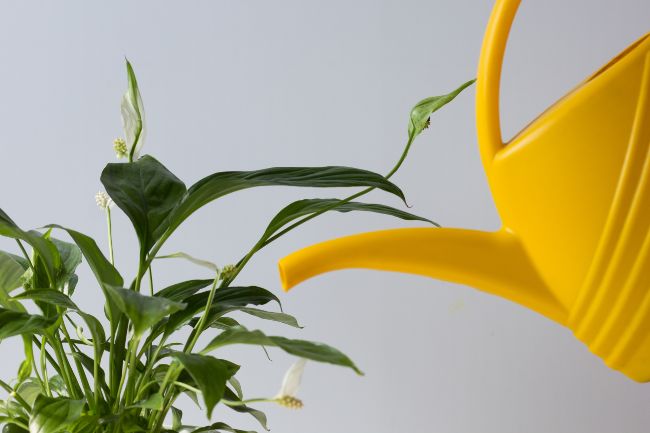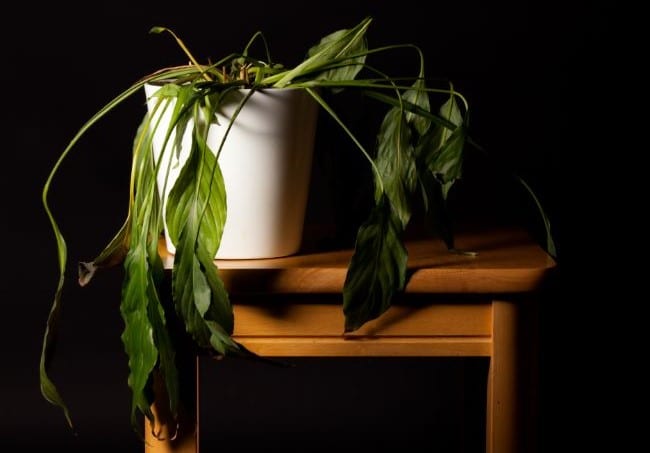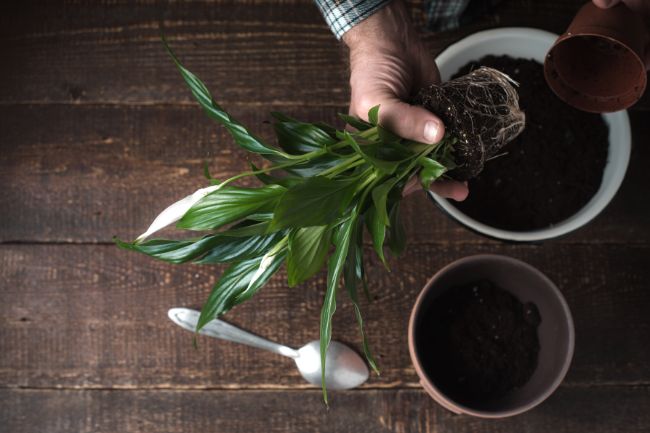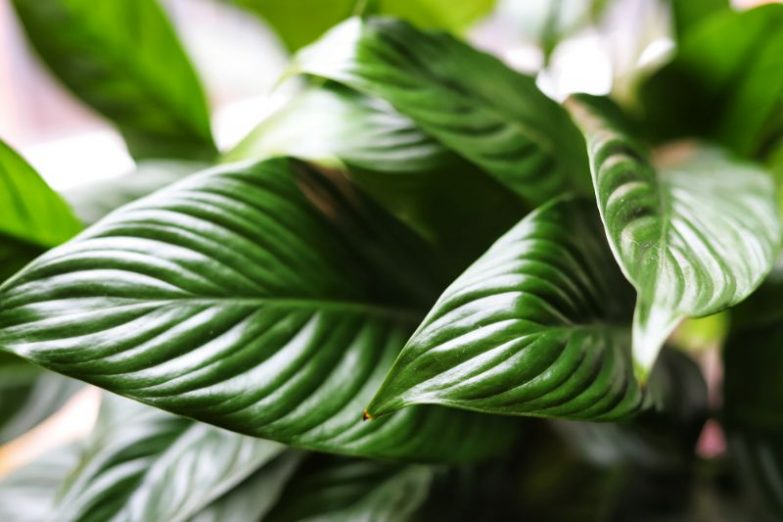The lovely, bounteous Peace Lily (Spathiphyllum) is usually easy to maintain indoors. It’s upsetting when things go wrong, but this houseplant often bounces back with proper care. Let’s look at why your Peace Lily might be dying and the steps to help bring it back.
Overwatering is the most common cause of a Peace Lily dying. Look for yellow, wilting foliage, and signs of root rot. Treat promptly, and avoid watering on a schedule. Underwatering, cold temperatures, nutrient problems, pests, or disease can also stress your plant and cause decline.
How To Fix A Dying Peace Lily
The chance for your Peace lily to recover is good if the problem isn’t too advanced. It can be a challenge to reverse course once a Spathiphyllum has started to decline, but they are pretty tough customers and will mount a comeback if you correct the issue in time.
Most ailing specimens will show distress and discoloration in their leaves, but trouble most often starts in the roots. Gently unpot and inspect the rootball: you want to find white, firm roots with an earthy smell.
You can remove damaged foliage, but consider keeping partly green leaves – these still produce energy your plant needs to heal. You can trim away brown spots for ornamental reasons, but stay inside the dead zone and avoid cutting into green material.
Other tips:
- Sterilize your cutting tools with isopropyl (rubbing) alcohol to avoid introducing or spreading pathogens.
- Snip leaves off at their base.
- Don’t apply fertilizer to a sick plant in hopes of giving it a boost—this can shock the root system and add to soil toxicity.
- Though they adapt to lower humidity, Peace lilies do better with higher levels. High humidity can be a secret weapon to help them recover.
- Good air circulation is beneficial.
- Healing takes time, so be patient.
Dying Leaves Are Not Always A Problem
Don’t worry about the occasional loss of older leaves from your Peace Lily; it’s probably just Mother Nature taking her course. You can trim away unsightly foliage if other healthy leaves remain.
Also, don’t be alarmed if their lovely white flowers (spathes) start to die. They may turn green before becoming brown, but the entire flower stem can be safely removed.
Reasons Why Your Peace Lily May Be Dying
Overwatering
The number one cause of a Peace Lily dying is too much water. They are thirsty plants, especially in hot weather, and love moist soil … but they’ll drown in a heavy, sodden mix.
It’s best to let the soil dry out a bit between watering sessions to oxygenate the roots and keep fungal problems at bay. Allow the top few inches dry out before thoroughly rewatering. Run an excess through the soil to completely rehydrate the mix and flush the soil.
Peace lilies wilt dramatically when they need water: the ideal time to rewater is just before they start to wilt. With experience, you’ll be able to judge the optimal moment.
Here are some considerations:
- Be aware that the plant’s water consumption varies according to environmental conditions. One common reason for overwatering is following a regular schedule that doesn’t adjust to colder temperatures or lower light levels.
- If the plant’s pot is inside a decorative outer container, be sure to check that no water is standing at the bottom. Empty any cache receptacles after watering.
- The classic symptom of overwatering is yellowing leaves, but the foliage can also turn brown, usually on the tips and edges.
- If your plant is wilting in wet soil, it probably means rot has set in and killed the roots. Don’t let things get this far! Check the soil: root rot has a foul, telltale odor.
- The basic treatment for overwatering is to let the soil dry and then resume a proper regime. If you want to try salvaging a plant with root rot, trim away the decayed material and repot in fresh soil.

Underwatering
If your Peace lily is suffering from being underwatered, you’ll probably know – it’s hard to miss a plant that’s collapsed all over its pot. They don’t suffer in silence, so to speak.
Peace Lilies typically spring back to life once thoroughly watered, a trait that helps give them a forgiving reputation. It’s great that the plant “talks” to us about being thirsty, but don’t push it too far.
A water-stressed plant may not totally recover; damage shows up as lackluster growth, brown areas that never regreen, and increased leaf loss.
Your plant could be suffering chronic drought if it’s severely rootbound and the rootball isn’t being thoroughly moistened. You can unpot the plant to inspect the roots, or insert a wooden chopstick or pencil into the roots after a watering and check for dry spots.
If you’ve determined that underwatering is the problem, give the soil a good soaking to rehydrate parts of the mix that may repel water when dry. Don’t water more frequently afterwards to “make it up,” just return to proper watering and monitor more diligently in the future.
Low Temperatures Or Drafts
Peace Lilies thrive at normal household temperatures but are stressed when conditions fall below 41ºF (5ºC). Extremely cold temperatures can result in a Peace Lily dying.
Yellow or blackened leaves are possible signs of cold-induced trauma. You may not get much of a warning before the damage is done, so be careful to protect them.
Note: Windowsills can become unexpectedly cold, so keep the plant away from uninsulated glass. These areas warm up during the daytime; some growers temporarily move them from the sill at night or during a cold snap.
Drafts are another potential threat, especially if the air is very hot or cold.
Improper Lighting
Peace Lilies are one of the best houseplants for low light – they can even flower in fairly dim conditions – but they can’t grow in virtual darkness. They can suffer and stagnate if the light is too low, but it’s usually obvious if this is the cause.
Light shade is their natural preference, but outdoor shade is brighter than most indoor illumination. Symptoms of low light stress include brown or yellow leaves. Low light can cause smaller leaves and slow growth, too.
It’s an easy problem to fix: simply provide brighter conditions. Peace Lilies can prosper in a north-facing window and do well under fluorescent lighting.
They can handle bright indirect light, too, but quickly scorch in direct sun. Gentle morning sun is generally okay, but if the plant is getting direct sun and you see brown spots, it needs more protection.

Disease
You can minimize the risk of disease by avoiding plant stress. Try to keep the foliage dry, as several of the potential pathogens are easily spread through water.
Cylindrocladium spathiphylli is the most common pathogen affecting Peace Lilies. It’s a root infection that starts out with reddish-brown lesions and progresses to total root collapse and rot. Early symptoms are wilting and yellowed lower leaves.
This water-borne disease is most active in warm weather. It’s generally best to discard plants with advanced symptoms, but dispose of infected material carefully: the spores are highly infectious. Treat nearby plants with triflumizole.
Phytophthora parasitica is another common Spathiphyllum pathogen. It causes similar symptoms as Cylindrocladium – wilting, yellowed foliage, and root damage. It infects the soil and spreads easily through contaminated mix.
Take care to keep the leaves dry if you suspect a Phytophthora infection, and safely discard severely affected specimens. Dose remaining plants with either fosetyl aluminum or metalaxyl.
Pests
As long as you don’t let an infestation take over, your Peace Lily is unlikely to succumb to pests alone. The plant isn’t overly susceptible, so an invasion is often a sign that some other stress has lowered the plant’s defenses.
The main unwelcome visitors you’re likely to see are the common houseplant pests: aphids, mealybugs, and scale. Dry conditions are also an invitation to spider mites.
You can dispatch individual bugs with a dab of rubbing alcohol; insecticidal soap is an excellent, plant-gentle remedy for larger infestations. Take the plant to the shower and douse it with the soapy solution. Soak underneath leaves and crevices: the solution needs to touch the insects to kill them. Repeat every four to seven days until the situation is under control.
Note: If you’ve recently watered, avoid further soaking of the soil by wrapping the pot in plastic.
Other Stress Factors
It may be that a single major problem isn’t the cause of your Peace Lily dying, but instead lesser factors are contributing to its overall stress and decline. These issues add up to a sick plant over time, but they aren’t usually deadly by themselves.
Rootbound Conditions
Peace Lilies do fine in tight quarters and can live for years in the same container, but there are limits. If the rootball is constricted, it will cause health effects.
Waiting to repot until the plant is already failing is not the best idea. Repotting can be very stressful: new soil and inevitable damage to the delicate roothairs can shock the plant. Overpotting also results in a large quantity of empty soil that makes it harder to water properly.
Here are tips to successful repotting:
- Repot when roots have filled the container and are displacing soil. One sign is needing to water much more frequently.
- Spring is the best time to repot.
- Try to match the new mix to the old soil’s makeup.
- Only go up one pot size, or no more than two inches in diameter.
- Don’t fertilize for the first two months after repotting to avoid burning the sensitive new roots.
- Read more about repotting houseplants here.

Nutritional Deficiency
Peace Lilies are light feeders, so undernutrition is not a common problem. Even so, the lack of certain nutrients can indirectly stress the plant … and a rootbound plant can deplete its soil.
Symptoms include sluggish growth and pale or discolored, stunted leaves.
An application every six weeks in the growing season is recommended. Use a balanced fertilizer at half the suggested strength. If you’ve determined the problem is poor soil and you haven’t fed the plant recently, you can immediately apply a dose of fertilizer (at a half-strength dilution).
Don’t overfeed to “catch up” … just resume normal applications. It’s tempting to try to boost an ailing plant with extra feedings, but this is usually counterproductive.
Soil Toxicity
Peace Lilies are easy to overfertilize. Excess fertilizer residue can create a salt buildup that toxifies the soil and inhibits the roots.
Symptoms of fertilizer burn often show as brown leaf tips, but more severe toxification of the soil causes stunting and yellowed, dying foliage, leading to an overall decline of the plant.
Flushing the soil is the recommended treatment for washing out fertilizer residue, and it’s a good regular practice. At watering time, run an extra amount of water through the soil and let the excess flow out the drainage holes.
Water Quality Issues
Poor water quality is another form of toxicity that can damage your Peace Lily. The plant isn’t highly sensitive to elevated chemical and/or mineral content, but it can make a difference. Though not usually fatal, poor water quality can hamper growth and add to plant stress.
Symptoms include brown leaf tips and discolored foliage.
Most municipal sources are treated with chloramine which doesn’t evaporate like chlorine does, so aging water by letting it sit out overnight doesn’t help. An inexpensive dechlorinator used for aquariums will do the job … or, of course, you can use rainwater, purified, or distilled water.
Learn more about the impact of water quality and type for the health of your houseplants in this article.
Note: Use room-temperature water to avoid shocking the plant’s roots with cold water.
Relocation
Peace lilies aren’t overly dramatic about being relocated, but they still need time to acclimate. If the change is drastic or to a poorer environment, they may languish and show distress in their leaves … but moving doesn’t often cause critical damage.
Still, it’s a factor to consider if your plant is doing poorly. Be patient and don’t make other big changes until the plant recovers. New growth is a good sign that your Peace lily has adjusted.
Last Word
Hopefully, this article will help you get your Peace Lily back to perfect health in no time. If you’d like to learn more, you may like to check out some of my other articles about Peace Lilies.
- How To Care For Peace Lilies.
- How To Stop Your Peace Lily Drooping.
- Why Do Peace Lily Leaves Turn Yellow?
- How To Water Peace Lilies.
- Peace Lily Meaning And Symbolism.
- Why Is Your Peace Lily Not Blooming?
- Peace Lily Overwatering Symptoms, And How To Fix Them.
- 5 Common Peace Lily Problems And Simple Solutions.

